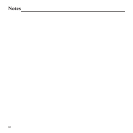
interference noise from your wireless phone.
Hearing devices may also be measured for immunity
to this type of interference. Your hearing device
manufacturer or hearing health professional may help
you find results for your hearing device.
For additional information about the FCC’s actions with
regard to hearing aid compatible wireless devices and
other steps the FCC has taken to ensure that individuals
with disabilities have access to telecommunications
services, please go to www.fcc.gov/cgb/dro.
HAC for Newer Technologies
This phone has been tested and rated for use with
hearing aids for some of the wireless technologies that
it uses. However, there may be some newer wireless
technologies used in this phone that have not been
tested yet for use with hearing aids. It is important to
try the different features of this phone thoroughly and
in different locations, using your hearing aid or cochlear
implant, to determine if you hear any interfering noise.
Consult your service provider or the manufacturer of
this phone for information on hearing aid compatibility.
If you have questions about return or exchange policies,
consult your service provider or phone retailer.
Road Safety
Driving
Full attention must be given to driving at all times in
order to reduce the risk of an accident. Using a phone
while driving (even with a hands-free kit) can cause
distraction and lead to an accident. You must comply
with local laws and regulations restricting the use of
wireless devices while driving.
Operating Machinery
Full attention must be given to operating the machinery
in order to reduce the risk of an accident.
Product Handling
General Statement on Handling
and Use
You alone are responsible for how you use your phone
and any consequences of its use.
You must always switch off your phone wherever the
use of a phone is prohibited. Use of your phone is
subject to safety measures designed to protect users
and their environment.
• Always treat your phone and its accessories with
care and keep it in a clean and dust-free place.
• Do not expose your phone or its accessories to open
flames or lit tobacco products.
• Do not expose your phone or its accessories to
liquid, moisture, or high humidity.
• Do not drop, throw, or try to bend your phone or
its accessories.
• Do not use harsh chemicals, cleaning solvents, or
aerosols to clean the device or its accessories.
• Do not paint your phone or its accessories.
• Do not attempt to disassemble your phone or its
accessories; only authorized personnel can do so.
For Your Safety
79
information, including the HAC rating of this product,
please refer to www.zteusa-support.com.
When some wireless phones are used near some
hearing devices (hearing aids and cochlear implants),
users may detect a buzzing, humming, or whining
noise. Some hearing devices are more immune than
others to this interference noise, and phones also
vary in the amount of interference they generate. The
wireless telephone industry has developed ratings for
some of their mobile phones to assist hearing device
users in finding phones that may be compatible with
their hearing devices. Not all phones have been rated.
Phones that have been rated have a label on the box.
Your Z665C has been tested for hearing aid
device compatibility and has an M4/T4 rating.
These ratings are not guaranteed. Results will vary,
depending on the level of immunity of your hearing
device and the degree of your hearing loss. If your
hearing device happens to be vulnerable to interference,
you may not be able to use a rated phone successfully.
Trying out the phone with your hearing device is the
best way to evaluate it for your personal needs.
M-Ratings: Phones rated M3 or M4 meet FCC
requirements and are likely to generate less interference
with hearing devices than phones that are not labeled.
M4 is the better/higher of the two ratings.
T-Ratings: Phones rated T3 or T4 meet FCC
requirements and are likely to be more usable with a
hearing device’s telecoil (“T Switch” or “Telephone
Switch”) than unrated phones. T4 is the better/higher
of the two ratings. (Note that not all hearing devices
contain telecoils.) The more immune your hearing
aid device is, the less likely you are to experience
For Your Safety
78
CAUTION: Changes or modifications not expressly
approved by the manufacturer could void the user’s
authority to operate the equipment.
NOTE: This equipment has been tested and found
to comply with the limits for a Class B digital device,
pursuant to part 15 of the FCC Rules. These limits are
designed to provide reasonable protection against
harmful interference in a residential installation. This
equipment generates, uses and can radiate radio
frequency energy and, if not installed and used in
accordance with the instructions, may cause harmful
interference to radio communications. However, there
is no guarantee that interference will not occur in a
particular installation. If this equipment does cause
harmful interference to radio or television reception,
which can be determined by turning the equipment
off and on, the user is encouraged to try to correct the
interference by one or more of the following measures:
• Reorient or relocate the receiving antenna.
• Increase the separation between the equipment
and receiver.
• Connect the equipment into an outlet on a circuit
different from that to which the receiver
is connected.
• Consult the dealer or an experienced radio/TV
technician for help.
Using Your Phone with a
Hearing Aid Device
Your Z665C is compliant with the FCC Hearing Aid
Compatibility (HAC) requirements. For additional HAC


















